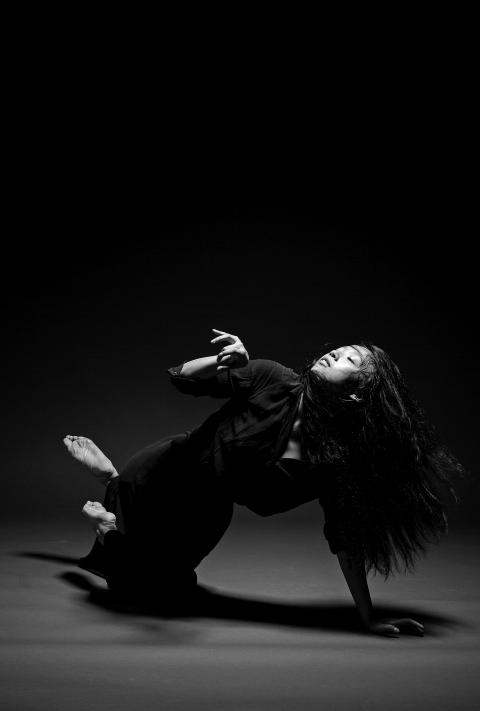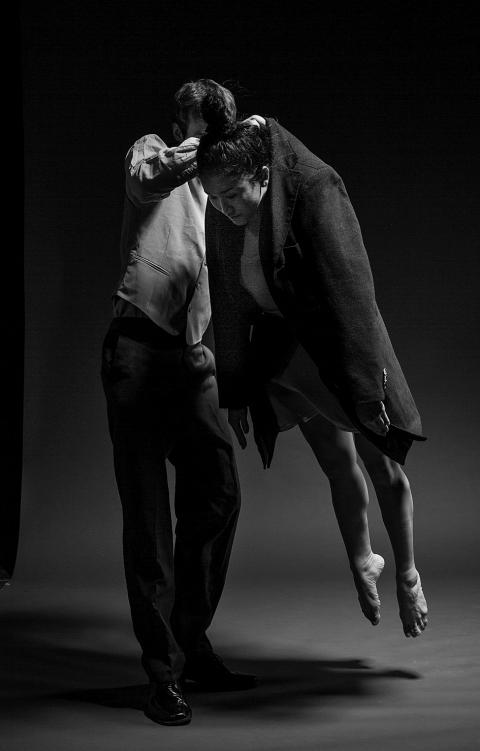This was a year of standout performances by young male choreographers, two females and some older hands, showing there is a lot of up and coming Taiwanese artists and experienced ones to reinvent themselves.
It was also a year that proved that the most surprising and memorable shows could appear when you least expect it.
‘GARDENIA’ AND ‘MAATAW’

Photo: Courtesy of Terry Lin
The year got off to a blooming start with Wu Chien-wei’s (吳建緯) Gardenia (六出) at Taipei’s Wellspring Theater for his Tussock Dance Theater (野草舞蹈聚落). Wu created a smart, intriguing duet with Cheng Hao (鄭皓) that got an extra kick from costumes by London-based Taiwanese fashion designer Johan Ku (古又文).
The Formosa Indigenous Dance Foundation of Culture and Arts (原住民族樂舞劇) took a swing at vested interests in its January production of Maataw: the Floating Island (浮島) at the National Theater, a powerful indictment of the government’s exploitation of the Tao of Orchid Island (Lanyu, 蘭嶼) that also highlighted the callous disregard and disrespect shown by the ever-growing number of tourists toward the the island’s residents.
The company was able to tour Maataw to Aboriginal communities nationwide over several months, but given the Council of Indigenous Peoples’ reported dislike of the strongly political work, one cannot help buy wonder if the council will as generous toward future works by the troupe.

Photo: Courtesy of Terry Lin
TONGUES ARE WAGGING
Cloud Gate 2’s (雲門2) artistic director Cheng Tsung-lung’s (鄭宗龍) 13 Tongues (十三聲) in March at the National Theater found him pushing through his usual comfort zone in terms of a longer length (70 minutes) and a move away from abstract works to a more personal one, based on memories of his childhood in Taipei’s Wanhua District (萬華).
Audiences might have been worried about their comfort level heading into the Cloud Gate Theater for Liu Kuan-hsiang’s (劉冠詳) Kids(我知道的太多了) in May, which was about his terminally ill mother’s final months and his interactions with her.
However, the piece, produced by the Horse troupe (驫舞劇場) and featuring Liu’s wife, Chien Ching-ying (簡晶瀅), as well as Lin Yu-ju (林祐如), turned out to be a powerfully touching work that was ultimately uplifting.
It also helped put Liu on Cloud Gate Dance Theatre’s (雲門舞集) radar, and he has been tapped to create a piece for Cloud Gate 2’s Spring Riot next year.
It was great to see Europe-based Lee Chen-wei’s (李貞葳) Together Alone (孤單在一起), at the beginning of June. The duet with Hungarian dancer and actor Vakulya Zoltan for the National Theater Concert Hall’s “Innovation Series” reinforced the reputation Lee has created with her solos in recent years for Ho Hsiao-mei’s (何曉玫) Meimage Dance Company’s New Choreographer Project.
STANDOUT PERFORMANCE
The standout performance in this year’s New Choreographer Project was by Germany-based Tien Tsai-wei (田采薇), a member of Tanztheater Wuppertal Pina Bausch, a duet with German dancer Jan Moellmer titled, The Man.
I have long been a fan of Bulareyaung (Bula) Pagarlava’s work, whether for Cloud Gate, Cloud Gate 2 or other troupes, but Colors (漂亮漂亮) for his Bulareyaung Dance Company (布拉瑞揚舞團) at the Cloud Gate Theater in October was a delight from start to finish.
Lighting/stage designer Li Chien-chang (李建常) and Bula were able to evoke the blues of Taitung’s sky and seashore and the sounds of the ocean with creative lighting and several large blue and white striped plastic tarps, while Bula’s choreography brought out the best in his dancers.
The Taipei National University of the Arts’ Dance Department’s annual Winter Dance Concert showed why its students, alumni and faculty continue to dominate Taiwan’s dance world.
‘ALTERNATE REALM’
While department chairman Zhang Xiaoxiong (張曉雄) has created a long list of solid works, and his Guang Ling Verse (廣陵散) was a gorgeous, complicated piece for 10 male dancers set to guqin (古琴) music that was mesmerizing to watch, it was young (26) choreography student Chang Kuo-wei’s (張國韋) Alternate Realm (鏡界) that proved to be the highlight of the show.
Chang blended hip-hop moves with contemporary technique and choreographed the movements of six large mirrors to create a multi-layered piece that was visually captivating and artistically challenging for its all-male cast.
This year was also memorable – on a sadder note – for the retirement from the repertoire of two beloved Lin Hwai-min (林懷民) works for Cloud Gate, 1994’s Songs of the Wanderers (流浪者之歌), and the classic Moon Water (水月) from 1988.
While Lin and company members insist the retirement is not permanent, any talk of returning the two to the line-up appears to be several years away.

Most heroes are remembered for the battles they fought. Taiwan’s Black Bat Squadron is remembered for flying into Chinese airspace 838 times between 1953 and 1967, and for the 148 men whose sacrifice bought the intelligence that kept Taiwan secure. Two-thirds of the squadron died carrying out missions most people wouldn’t learn about for another 40 years. The squadron lost 15 aircraft and 148 crew members over those 14 years, making it the deadliest unit in Taiwan’s military history by casualty rate. They flew at night, often at low altitudes, straight into some of the most heavily defended airspace in Asia.

This month the government ordered a one-year block of Xiaohongshu (小紅書) or Rednote, a Chinese social media platform with more than 3 million users in Taiwan. The government pointed to widespread fraud activity on the platform, along with cybersecurity failures. Officials said that they had reached out to the company and asked it to change. However, they received no response. The pro-China parties, the Chinese Nationalist Party (KMT) and Taiwan People’s Party (TPP), immediately swung into action, denouncing the ban as an attack on free speech. This “free speech” claim was then echoed by the People’s Republic of China (PRC),

Many people in Taiwan first learned about universal basic income (UBI) — the idea that the government should provide regular, no-strings-attached payments to each citizen — in 2019. While seeking the Democratic nomination for the 2020 US presidential election, Andrew Yang, a politician of Taiwanese descent, said that, if elected, he’d institute a UBI of US$1,000 per month to “get the economic boot off of people’s throats, allowing them to lift their heads up, breathe, and get excited for the future.” His campaign petered out, but the concept of UBI hasn’t gone away. Throughout the industrialized world, there are fears that

Like much in the world today, theater has experienced major disruptions over the six years since COVID-19. The pandemic, the war in Ukraine and social media have created a new normal of geopolitical and information uncertainty, and the performing arts are not immune to these effects. “Ten years ago people wanted to come to the theater to engage with important issues, but now the Internet allows them to engage with those issues powerfully and immediately,” said Faith Tan, programming director of the Esplanade in Singapore, speaking last week in Japan. “One reaction to unpredictability has been a renewed emphasis on